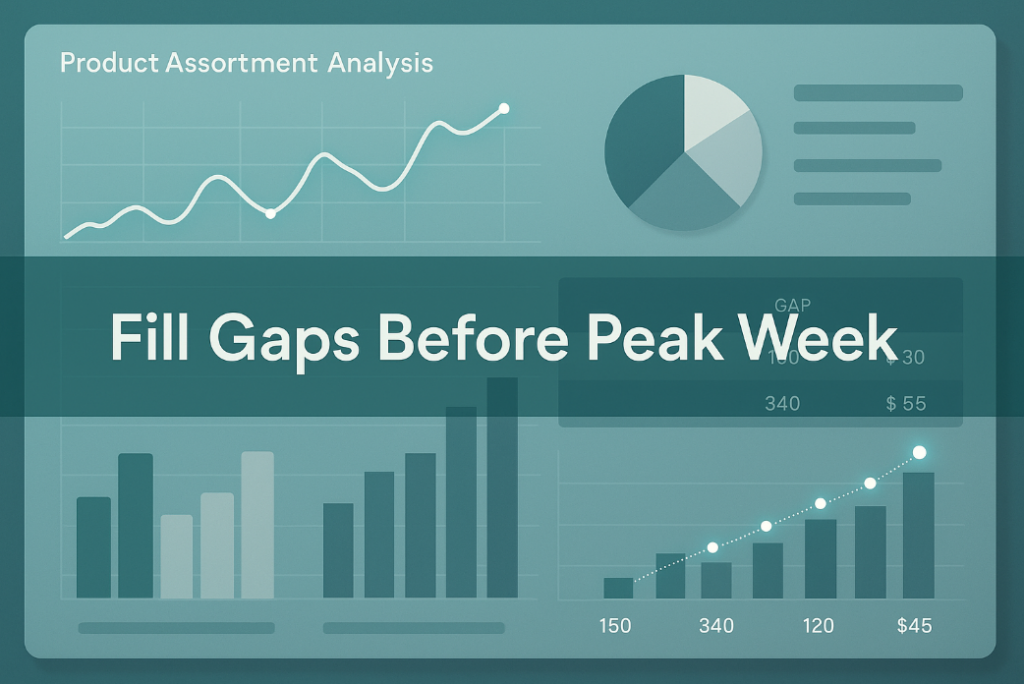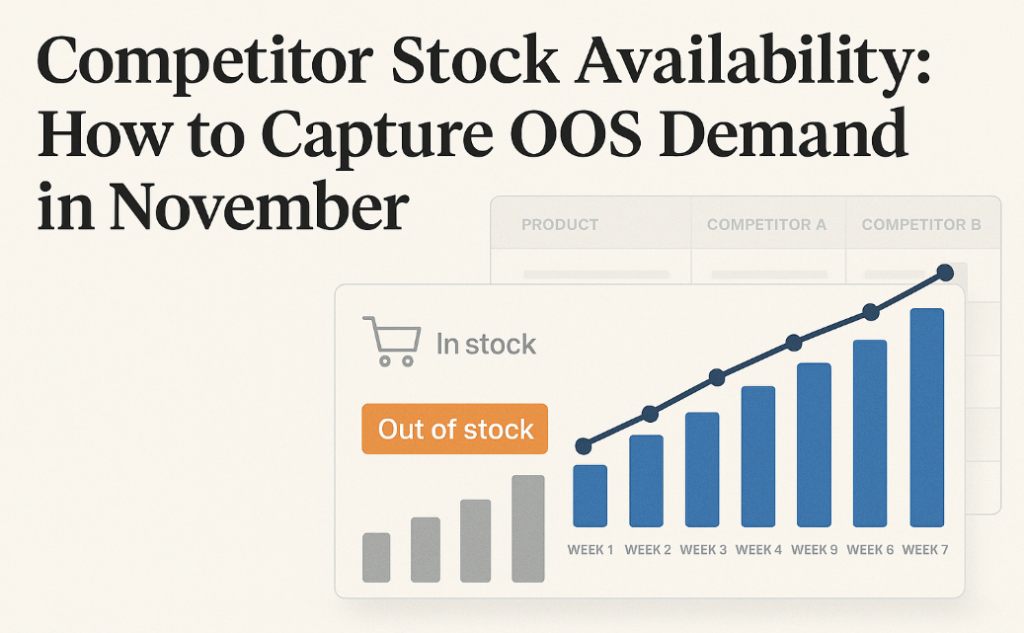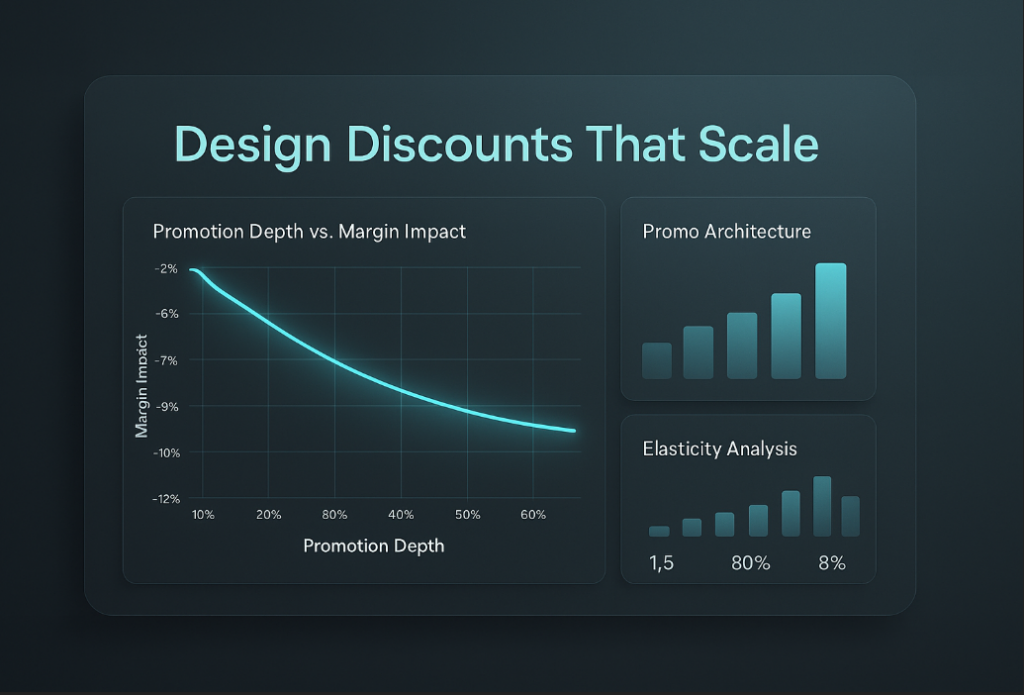- Product
- Solution for
For Your Industry
- Plans & Pricing
- Company
- Resources
For Your Industry
As retail enters its most critical period, peak week, assortment planning becomes the defining factor between record-breaking profits and missed opportunities. Product assortment analysis empowers retailers to ensure the right products are available in the right quantities, at the right time.
In today’s data-rich retail environment, relying on historical intuition is no longer enough. Retailers must combine pricing intelligence, demand forecasting, and competitive analytics to fill assortment gaps before peak week hits.
tgndata’s advanced retail analytics platform helps brands pinpoint missing SKUs, optimize inventory depth, and align pricing strategies with real-time market signals—ensuring every shelf, digital or physical, is performance-optimized.

Product assortment analysis evaluates the breadth and depth of a retailer’s product range to ensure it aligns with customer demand, category strategy, and market trends. It answers three key questions:
Do we have enough variety to meet customer preferences?
Are our top-selling SKUs adequately stocked?
Which products are underperforming or redundant?
The goal is to create an assortment that balances choice with efficiency, maximizing sales and minimizing overstock risk.
Breadth: The range of product categories and subcategories.
Depth: The number of SKUs or variations within each category.
Performance Metrics: Sales velocity, margin contribution, and turnover rate.
Competitor Benchmarking: Market coverage versus competing retailers.
Together, these data points reveal where assortment gaps exist and where to allocate resources for maximum impact during peak week.
Peak week—typically the highest sales week in a season or promotional calendar—demands precision. Retailers often see 30–50% of seasonal sales concentrated in this short window, meaning any gap or misalignment in the assortment can significantly impact total revenue.
Stockouts of high-demand SKUs lead to lost sales and brand frustration.
Overstocking slow movers ties up capital and reduces agility.
Pricing misalignment can erode competitiveness during critical promotional days.
Proactive product assortment analysis helps retailers mitigate these risks by modeling demand, simulating pricing elasticity, and identifying missing assortment depth well before the peak period begins.
Filling assortment gaps before peak week requires a mix of analytics, automation, and category intelligence. tgndata’s platform leverages these components to guide decision-makers toward profitable actions.
Use predictive analytics to surface products with the highest potential uplift during peak week based on:
Seasonal demand trends
Search frequency and conversion data
Historical sales lift during similar events
This ensures assortment investments are guided by data, not guesswork.
tgndata’s competitive retail analytics tools allow brands to see assortment overlaps and white space opportunities by comparing SKUs across competitors. For example:
| Metric | Retailer A | Retailer B | Your Store |
|---|---|---|---|
| SKU Coverage (%) | 85 | 78 | 64 |
| Category Breadth | 12 | 10 | 8 |
| Price Index | 101 | 99 | 103 |
Insights like these highlight where assortment coverage lags behind market leaders and where pricing adjustments can improve competitiveness.
Not every product deserves shelf space during peak week. Use sales velocity and margin contribution data to flag underperforming SKUs for delisting or discounting. This clears space and budget for high-demand products that drive revenue.
Pricing and assortment must move together. Dynamic pricing models ensure your best sellers remain competitive while maintaining margin integrity. When paired with inventory optimization, retailers can prevent stockouts and price-based revenue leakage simultaneously.
Modern assortment analysis extends beyond static SKU counts. It incorporates AI-driven demand forecasting that adjusts for factors like:
Search trend acceleration
Market share shifts
Competitor promotions
Real-time availability
By combining internal sales data with tgndata’s external market intelligence, retailers can model SKU-level demand curves and plan replenishments before peak week starts.
| SKU | Forecasted Peak Sales | Current Stock | Reorder Need | Risk Level |
|---|---|---|---|---|
| SKU-124 | 3,200 | 1,200 | 2,000 | High |
| SKU-378 | 980 | 1,050 | 0 | Low |
| SKU-220 | 5,600 | 3,000 | 2,600 | Critical |
Such insights allow for proactive restocking and more accurate promotion targeting.
Assortment elasticity measures how changes in the number of available SKUs affect sales volume. Too narrow an assortment reduces choice, while too wide dilutes focus.
Using elasticity modeling, tgndata helps retailers:
Identify optimal SKU counts per category
Forecast incremental revenue from expanding assortment breadth
Quantify the impact of SKU rationalization on margin
This data ensures every product contributes meaningfully to peak week performance.
A well-structured product assortment plan ensures retailers can act quickly as demand patterns shift.
Analyze current assortment coverage across top-performing categories.
Benchmark competitive assortments to identify white spaces.
Prioritize SKU additions based on demand forecasting and margin potential.
Align pricing strategy with assortment depth and competitor trends.
Automate restock triggers through inventory forecasting tools.
tgndata’s unified retail intelligence suite automates these steps, ensuring consistency and speed across teams.
Even advanced retailers can fall into these traps before peak week:
Relying on last year’s data without accounting for new trends.
Ignoring competitive product introductions.
Overfocusing on price cuts without balancing assortment strength.
Delaying replenishment decisions until stockouts occur.
Avoiding these pitfalls requires a data-first mindset, continuous monitoring, and integration between pricing, assortment, and inventory systems.
tgndata’s retail analytics platform provides end-to-end visibility across assortment, pricing, and performance metrics.
AI-driven assortment gap detection
Dynamic pricing integration
Competitor benchmarking dashboards
SKU-level demand forecasting
Automated replenishment insights
These tools help retailers fill assortment gaps early, ensuring readiness for peak week and sustained profitability throughout the season.
Product assortment analysis is not a last-minute exercise. It’s a proactive strategy that ensures you have the right products, at the right price, ready for the moment your customers start buying most.
By integrating tgndata’s assortment optimization and pricing intelligence, retailers can fill assortment gaps before peak week, prevent stockouts, and capture every possible sale.
Take the lead this season—equip your team with tgndata’s retail analytics today.













Missing an important marketplace?
Send us your request to add it!